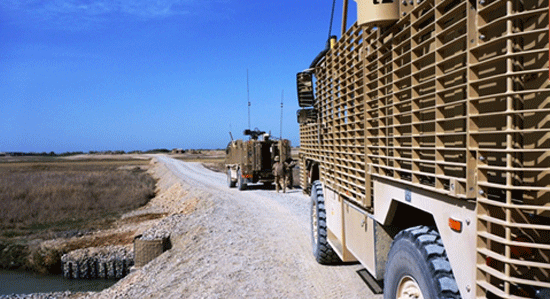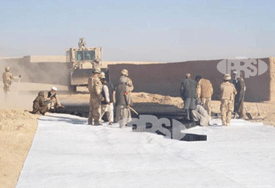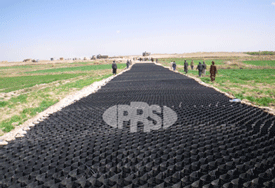Durable Pavement For UK Army & Afghan Population
Neoloy®Tough-Cells were used to construct new, safe and durable pavement for UK Army operations and Afghan civilian reconstruction.


Although British forces conducted successful military operations in the Helmand Province in Afghanistan in late 2009, insurgent activity continued to impede the movement for both local Afghans and troops along the only trafficable road through the area. The patrol bases were dependent upon air-dropped supplies, while civilian reconstruction efforts were impeded.
In order to stabilize the region, a new and secure route had to be created. This route had to connect the army patrol bases as well as provide safe and reliable transport for the local civilian population.
The British Army Royal Engineers, responsible for combat support and the development of critical infrastructure for the civilian population, were assigned the mission. They faced three key challenges according to Major Adam Foley (Eng.) who led the project. First the total budget was ₤3.5 million, in an area where the price of aggregate was exorbitantly high due to hostilities ($250-650 per cubic meter), thereby limiting its use. Second was how to cross a 300m-wide wadi (valley) and irrigation system. Last but not least was the concern for security along the route during construction and subsequent use.
The Neoloy Tough-Cell confinement system was chosen by the Royal Engineers after conducting trials with various infill materials and road make-ups.

Blazing a Trail in Reconstruction in Afghanistan, Ahead of Schedule, under Budget and Under Fire (see Video)
Construction Under Fire
Code named Route TRIDENT, the 7.6 km long road was designed and constructed by the British Army Royal Engineers 28 Regiment. Specialist Engineer road builders, including sappers and support forces and some 90 Afghan local vehicle operators and laborers were deployed in “construction battle groups”, which were subject to continuous sniper fire and improvised explosive devices (IEDs).
The Neoloy Tough-Cell road was designed for durability under heavy vehicles and harsh weather. The strong Neoloy based 3D confinement in the road base was infilled with locally dug soil (at zero cost). The composite system behaves like a semi-rigid beam, which distributes loads laterally and reduces sub-grade stress. Therefore aggregate was only required for the wearing course. Foley stated that Neoloy Tough-Cells allowed for a 75% reduction in the quantity of aggregate, and a reduction in the cost per meter by 2/3 compared to a normal unbound aggregate road.
Exceeding Expectations
On March 10th the first military convoy passed down route Trident without encountering ambushes. A trip which usually took 36 hours to complete, took less than 30 minutes! Foley said that “the convoy moved unhindered and unopposed along the new road in just 30 minutes proving its concept to be an undeniable success.”
The road passes through desert sand as well as farmer’s irrigated fields and canals, critical to the local agriculture. Large box culverts and a “floating” road comprised of Neoloy Tough-Cells were used to “forge” exceptionally waterlogged ground, which was previously impassable to vehicles. “The effect Route Trident is having on the local population along its length is already quite astounding,” says Foley. Shortly after completion, shops and markets sprung up along the route, while a doctor’s office and school are being built.
The design and construction techniques developed on Route Trident are being used the Royal Engineers across Helmand.
Click here to read more about using Neoloy for military road reinforcement
